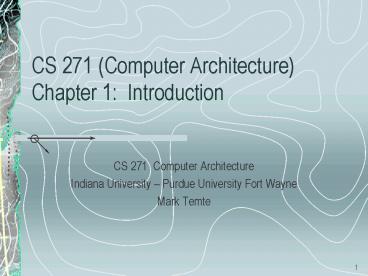CS 271 Computer Architecture Chapter 1: Introduction - PowerPoint PPT Presentation
1 / 23
Title:
CS 271 Computer Architecture Chapter 1: Introduction
Description:
Virtual machine. Call raw computer hardware M0 and the instruction set L0 ... Translation. Translation makes L1 programs practical for computer systems that are too ... – PowerPoint PPT presentation
Number of Views:51
Avg rating:3.0/5.0
Title: CS 271 Computer Architecture Chapter 1: Introduction
1
CS 271 (Computer Architecture)Chapter 1
Introduction
- CS 271 Computer Architecture
- Indiana University Purdue University Fort Wayne
- Mark Temte
2
Introduction to computer architecture
- Basic concept
- Hardware and software are logically equivalent
- Any operation executed by some computer hardware
can also be simulated in software - Any operation performed by software can be build
directly into the hardware of a computer system - Note hardware implementation might be very
complicated or costly
3
Hardware computer system
- Very fast
- Typically has an instruction set consisting of
simple operations - MOV
- ADD
- BZ
- etc.
- Machine language for the instruction set
- Tedious to program
- Programs consist of a sequence of bits
4
Virtual machine
- Call raw computer hardware M0 and the instruction
set L0 - A virtual machine is a hypothetical computer M1
whose machine language is L1 - More human oriented
- May be too expensive or complicated to actually
build directly in hardware - If so, L1 programs can still be written for M1
- However, such programs cannot be directly
executed on M1
5
Translation
- Translation makes L1 programs practical for
computer systems that are too expensive to
actually build in hardware - Any program written in L1 must . . .
- either be translated to the L0 language prior
to execution on M0 - or be interpreted by software written in L0 and
running on M0
6
Translation
- Translation is done by a compiler
- A complier is an L0 program running on M0 that
translates the L1 program to L0 - The compiler output later runs on M0
- Interpreter
- An interpreter is an L0 program running on M0
- The interpreter translates and executes the L1
program instruction-by-instruction
7
Computer system
- Layers of virtual machines stacked on raw
hardware - Each virtual machine . . .
- provides an instruction set
- is translated to or interpreted by lower layers
8
(No Transcript)
9
Contemporary multilevel machine
- Typical virtual machine levels
- High-level-language (HLL) machine level
- Assembly language machine level
- Operating system machine level
- Instruction set architecture (ISA) level
- Microarchitecture level
- Digital logic level
- The digital logic level is hardware with
transistors, wires, power supply, etc.
10
(No Transcript)
11
Evolution of multilevel machines
- Three level architecture
- ISA level
- Microprogram level
- Digital logic level
- Concept due to Maurice Wilkes (1951, Cambridge)
- Microprogram level
- Interprets ISA instructions using the digital
logic level - Very small instruction set
- Easier to construct than ISA level
- Built-in, unchangeable
12
Evolution of multilevel machines
- Operating system level
- Adds instructions and features to the ISA level
- I/O instructions
- System macros
- Supervisor calls
- Etc.
- Added instructions are interpreted by the ISA
level - ISA instructions are executed directly
- (interpreted by the microprogram level)
13
Evolution of multilevel machines
- CISC (Complex Instruction Set Computer)
- Golden age for microprogram level - 1960s and
1970s - Increasingly sophisticated microprogram level
evolved - Instructions for floating point, procedure
call/return, etc. - Execution became slower
- RISC (Reduced Instruction Set Computer)
- Eliminates the microprogram layer
- Small instruction set is directly executed
- Increased execution speed, but at a price
- Remove Inconvenient Stuff to the Compiler
14
Milestones in computer architecture
15
Computer generations
- 0th 1642 1945 Mechanical
- 1st 1945 1955 Vacuum tubes
- 2nd 1955 1965 Transistors
- 3rd 1965 1980 Integrated circuits
- 4th 1980 - VLSI, personal computers
- 5th 1970s - Invisible computers
16
Moores Law
- The number of transistors on a chip doubles every
18 months - Gordon Moore (co-founder of Intel) 1965
- Not a law of nature
- Just an empirical observation
- Exponential growth at the rate of 60 per year
- Moores law has held from the 1960s until the
present - Increase from 103 to 108 transistors per chip
17
Moores Law
18
Spectrum of computers
19
Examples of computer architectures
We will refer to these examples throughout the
semester
20
Intel computer family
21
Intel computer family
Moores law for (Intel) CPU chips.
22
MCS-51 family
Members of the MCS-51 family.
23
Metric units
The principal metric prefixes.































